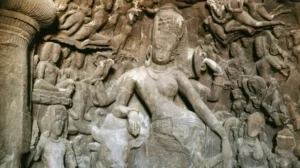Queer Sexuality In Indian Mythology
Unbelievably, Queer Sexuality love wasn’t always frowned upon in Indian culture. The evidence can be found in Indian mythology, which has been around for thousands of years and supports same-sex relationships.

The tale of Mitra and Varuna shows the depths of love while also providing gay Hindus with deities to worship. Both are regarded as Sun gods, and their connection is depicted as being one of great love. They are frequently seen paired atop a shark or riding side by side in a golden chariot pulled by seven swans. These two male gods conceived a child when their semen landed on a termite mound, according to the ancient scripture Bhagavata Purana, which is sometimes quoted as a lovely illustration of surrogacy with a mythological twist.
We can also find the tale of two queens who fall in love with one another and magically give birth to a child with the help of Lord Shiva in various translations of the Bengali mythological literature Krittivasa Ramayana.
Many Indian historians and mythologists have disputed the notion that everything gay is an import from the West, despite the fact that it is simple to assume that such progressive notions are foreign ones. An Indian mythologist named Sundeep Verma claims that he was shocked to find a video of a conservative UK anchor mocking the idea that there are simply too many sexualities in society nowadays.
He found the roughly 100 different sexualities to be annoying, according to Verma. However, it has always been a part of Indian mythology and history, as well as our scriptures.

According to Verma, the Kamatantra (manual of love) and Smriti-ratnavali (summary of Vedic rules) of Vacaspati, two Sanskrit dictionaries, the Sabda-kalpa-druma and the Smriti-ratnavali, both identify 20 different sorts of sexualities. “The Narada Smriti similarly cites 14 various kinds of sexual orientations, including three different kinds of homosexual males (mukhebhaga, kumbhika, and asekya) and trans individuals (sandha), intersex people (nisarga), and so forth. Additionally, it says that males who act like women or women who act like men are predetermined to do so at the time of conception in the womb, according to Verma.
But even in Indian history and mythology, according to Madhavi Menon, professor at Ashoka University and head of the Centre for Studies in Gender and Sexuality, queerness was not seen as anything strange or out of the ordinary.
Because desires refuse to be constrained by or by any identities, there is a celebration of the diversity of desires in Indian mythology, she said. “There are numerous groupings of men and men, women and women, and more if you look at the sculptures on the Khajuraho temple. This was a common story, and there is no evidence from history to suggest that it was surprising or profane.
She continued by saying that although there may be a separate chapter on gay love in the ancient treatise on sensual love, the Kamasutra, it is not distinct from human existence. There are numerous instances of this in Indian culture and history that, while they may not always be called outright, precisely oppose the regime of knowledge.
Even in medieval India, there are several instances of Queer Sexuality that aren’t explicitly referred to as such.’Boys of Delhi with their caps awry enough to drive their lovers wild,’ writes the great medieval poet Mir Taqi Mir. He does not imply that they are or that he is homosexual. There is a feeling that this is a part of the desire he perceives in Delhi and is engaging in.
Love has always existed in countless forms throughout Indian mythology, according to Alka Pande, an art historian and museum curator who taught Indian arts and aesthetics at Panjab University for more than ten years. Her main research interests are gender identity and sexuality, as well as traditional arts.
“We see the tale of Hari and Hara, two men who produced the god Ayappa. In a tale called Brihanala, Arjuna—a figure from the Hindu epic Mahabharata—dressed as a man to teach a princess the arts. Therefore, there are gay figures in our mythology and epics.
What therefore accounts for the current homophobia in light of such a long history of inclusivity? In accordance with Pande, regressive attitudes towards homosexuality and gay love are a result of Victorian conservatism and traditional moral principles.
Menon asserts that the British fought against all kinds of excesses, including those related to sensuality, religion, cuisine, and everything in between. She lamented that many people in the Indian subcontinent accept the British view of the region as the way things have always been.
According to Pande, the History of Sexuality series of works by Michael Foucault shows how sandwiches and piano legs were concealed in the Victorian era because they were seen to be suggestive. But as even gods are addressed as lovers, Indians have traditionally celebrated sexuality and sensuality.
Therefore, it should be second nature for Indians to comprehend and validate the various shades of queerness. These glimmers of gay-affirming history dispel the myth that Indian “values” and “morals” are in some way incompatible with Queer Sexuality.
Also, see
Tips To Help You Deal with Anxiety
Follow us on Instagram – here




